初中英语知识点微课课件 考点精讲 同课异构 28 过去完成时(12张PPT)
文档属性
| 名称 | 初中英语知识点微课课件 考点精讲 同课异构 28 过去完成时(12张PPT) | 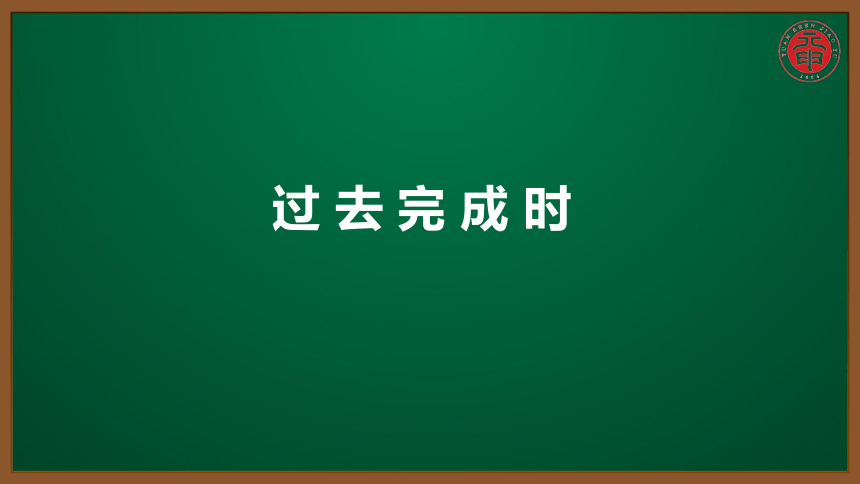 | |
| 格式 | ppt | ||
| 文件大小 | 475.5KB | ||
| 资源类型 | 试卷 | ||
| 版本资源 | 通用版 | ||
| 科目 | 英语 | ||
| 更新时间 | 2021-07-14 11:33:56 | ||
图片预览

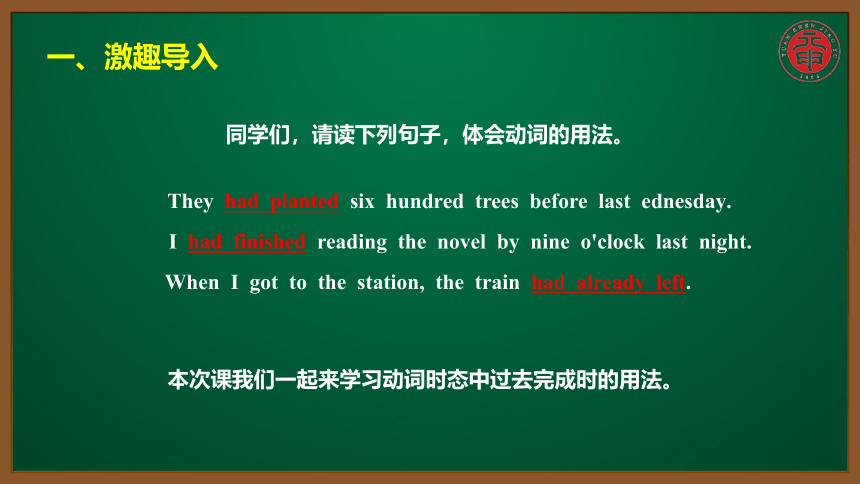
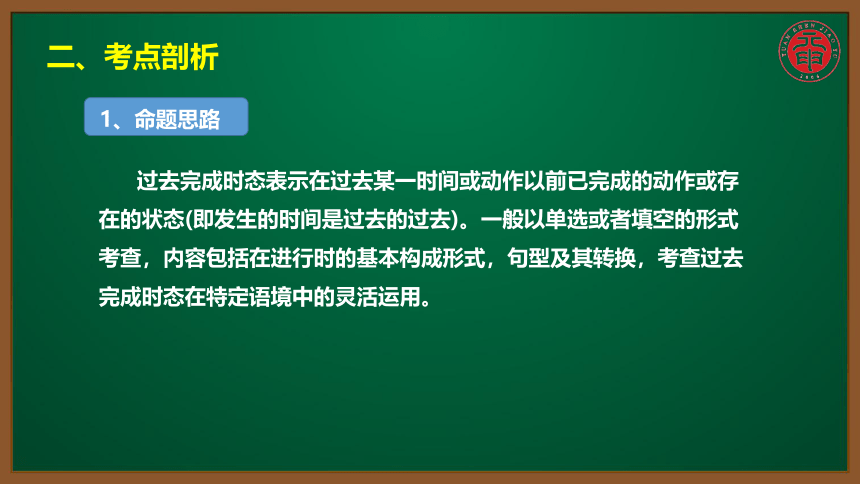
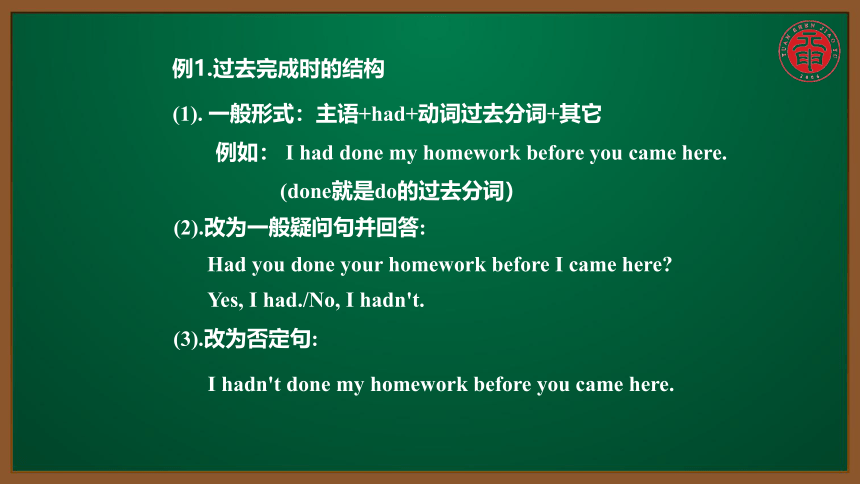
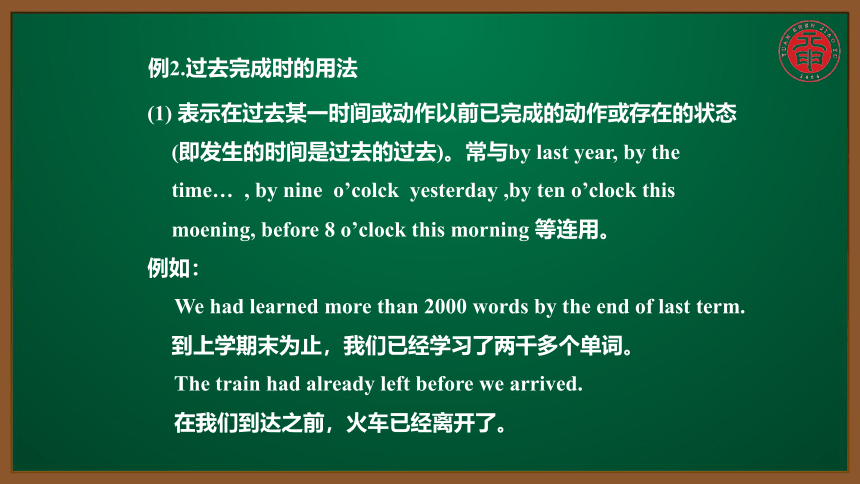
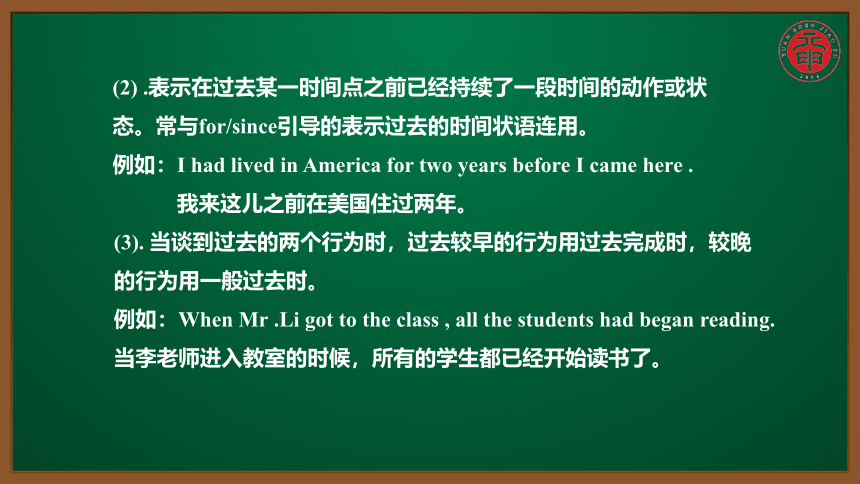
文档简介
过 去 完 成 时
一、激趣导入
本次课我们一起来学习动词时态中过去完成时的用法。
同学们,请读下列句子,体会动词的用法。
I?had?finished?reading?the?novel?by?nine?o'clock?last?night.?
?They?had?planted?six?hundred?trees?before?last?ednesday.?
?When?I?got?to?the?station,?the?train?had?already?left.?
二、考点剖析
1、命题思路
过去完成时态表示在过去某一时间或动作以前已完成的动作或存在的状态(即发生的时间是过去的过去)。一般以单选或者填空的形式考查,内容包括在进行时的基本构成形式,句型及其转换,考查过去完成时态在特定语境中的灵活运用。
(1). 一般形式:主语+had+动词过去分词+其它
例如: I had done my homework before you came here.
(done就是do的过去分词)
例1.过去完成时的结构
(2).改为一般疑问句并回答:
Had you done your homework before I came here?
(3).改为否定句:
Yes, I had./No, I hadn't.
I hadn't done my homework before you came here.
例2.过去完成时的用法
(1) 表示在过去某一时间或动作以前已完成的动作或存在的状态(即发生的时间是过去的过去)。常与by last year, by the time… , by nine o’colck yesterday ,by ten o’clock this moening, before 8 o’clock this morning 等连用。
例如:
We had learned more than 2000 words by the end of last term.到上学期末为止,我们已经学习了两千多个单词。
The train had already left before we arrived.
在我们到达之前,火车已经离开了。
(2) .表示在过去某一时间点之前已经持续了一段时间的动作或状态。常与for/since引导的表示过去的时间状语连用。
例如:I had lived in America for two years before I came here .
我来这儿之前在美国住过两年。
(3). 当谈到过去的两个行为时,过去较早的行为用过去完成时,较晚的行为用一般过去时。
例如:When Mr .Li got to the class , all the students had began reading. 当李老师进入教室的时候,所有的学生都已经开始读书了。
例3. 动词现在分词的变化规则:
preferring
watering
prefer
water
以er结尾的动词,如是重读音节结尾,先双写r,再加-ing。如不是重读音节结尾,就直接加-ing
lying
dying
tying
lie
die
tie
以ie结尾的短单词,把ie改为y,再加-ing
sitting
beginning
running
putting
sit
begin
run
put
以重读闭音节结尾的动词,如果末尾只有一个辅音字母,应先双写这个辅音字母,再加-ing
having
preparing
closing
have
prepare
close
以不发音字母e结尾的动词,先去掉e,再加-ing
listening
spending
staying
listen
spend
stay
一般在动词原形末尾加-ing
-ing形式
原形
规则
? 练习一:请选出正确的答案.
2、练一练
B
B
A
1. He ______ in Shanghai University for four years before he ______ Beijing.
A. studied, had gone B. had studied, went
C. has studied, goes D. had studied, had gone
2. Mary said it was at least five years since he ____ a good drink.
A. enjoyed B. was enjoying C. had enjoyed D. would enjoy3.
3. Xiao Pei said she ______ Hainan for 3 months.
A. has been in B. had been in C. had been to D. had gone to
4. We __ four?thousand?new?words?by?the?end?of?last?year. A.?had?learned??? B.?have?learned??? C.?learned???? D.?will?have?learned
C
练习二:用所给的动词的正确形式填空
1. When I returned home, he (leave).
2. By ten yesterday evening, she finish) writing.
3. He (study) English for five years before he came here.
4. It (stop) raining when I wake up this morning.
5. I (not read) the book because I had read it before.
6 . We (not see) each other since left Beijing.
7. When I got to his home, he (go) to bed.
8. She asked if Mr. Liu _____ already _____(come) back.
had studied?
had stopped?
didn't read
had gone?
hadn't seen
had come
had left
had finished??
3、答题技巧
掌握以下关于过去完成时的一些答题技巧:
1. 掌握过去完成时的用法:表示在过去某一时间或动作以前已完成的动作或存在的状态(即发生的时间是过去的过去),过去完成时态中常用的时间状语。
2.区分过去完成时与一般过去时及现在完成时的不同用法。
3.掌握过去完成时的基本结构及句型转换。
4.熟练掌握动词过去分词的变化规则。
三、思维导图
一、激趣导入
本次课我们一起来学习动词时态中过去完成时的用法。
同学们,请读下列句子,体会动词的用法。
I?had?finished?reading?the?novel?by?nine?o'clock?last?night.?
?They?had?planted?six?hundred?trees?before?last?ednesday.?
?When?I?got?to?the?station,?the?train?had?already?left.?
(2) .表示在过去某一时间点之前已经持续了一段时间的动作或状态。常与for/since引导的表示过去的时间状语连用。
例如:I had lived in America for two years before I came here .
我来这儿之前在美国住过两年。
(3). 当谈到过去的两个行为时,过去较早的行为用过去完成时,较晚的行为用一般过去时。
例如:When Mr .Li got to the class , all the students had began reading. 当李老师进入教室的时候,所有的学生都已经开始读书了。
三、思维导图
三、思维导图
一、激趣导入
本次课我们一起来学习动词时态中过去完成时的用法。
同学们,请读下列句子,体会动词的用法。
I?had?finished?reading?the?novel?by?nine?o'clock?last?night.?
?They?had?planted?six?hundred?trees?before?last?ednesday.?
?When?I?got?to?the?station,?the?train?had?already?left.?
二、考点剖析
1、命题思路
过去完成时态表示在过去某一时间或动作以前已完成的动作或存在的状态(即发生的时间是过去的过去)。一般以单选或者填空的形式考查,内容包括在进行时的基本构成形式,句型及其转换,考查过去完成时态在特定语境中的灵活运用。
(1). 一般形式:主语+had+动词过去分词+其它
例如: I had done my homework before you came here.
(done就是do的过去分词)
例1.过去完成时的结构
(2).改为一般疑问句并回答:
Had you done your homework before I came here?
(3).改为否定句:
Yes, I had./No, I hadn't.
I hadn't done my homework before you came here.
例2.过去完成时的用法
(1) 表示在过去某一时间或动作以前已完成的动作或存在的状态(即发生的时间是过去的过去)。常与by last year, by the time… , by nine o’colck yesterday ,by ten o’clock this moening, before 8 o’clock this morning 等连用。
例如:
We had learned more than 2000 words by the end of last term.到上学期末为止,我们已经学习了两千多个单词。
The train had already left before we arrived.
在我们到达之前,火车已经离开了。
(2) .表示在过去某一时间点之前已经持续了一段时间的动作或状态。常与for/since引导的表示过去的时间状语连用。
例如:I had lived in America for two years before I came here .
我来这儿之前在美国住过两年。
(3). 当谈到过去的两个行为时,过去较早的行为用过去完成时,较晚的行为用一般过去时。
例如:When Mr .Li got to the class , all the students had began reading. 当李老师进入教室的时候,所有的学生都已经开始读书了。
例3. 动词现在分词的变化规则:
preferring
watering
prefer
water
以er结尾的动词,如是重读音节结尾,先双写r,再加-ing。如不是重读音节结尾,就直接加-ing
lying
dying
tying
lie
die
tie
以ie结尾的短单词,把ie改为y,再加-ing
sitting
beginning
running
putting
sit
begin
run
put
以重读闭音节结尾的动词,如果末尾只有一个辅音字母,应先双写这个辅音字母,再加-ing
having
preparing
closing
have
prepare
close
以不发音字母e结尾的动词,先去掉e,再加-ing
listening
spending
staying
listen
spend
stay
一般在动词原形末尾加-ing
-ing形式
原形
规则
? 练习一:请选出正确的答案.
2、练一练
B
B
A
1. He ______ in Shanghai University for four years before he ______ Beijing.
A. studied, had gone B. had studied, went
C. has studied, goes D. had studied, had gone
2. Mary said it was at least five years since he ____ a good drink.
A. enjoyed B. was enjoying C. had enjoyed D. would enjoy3.
3. Xiao Pei said she ______ Hainan for 3 months.
A. has been in B. had been in C. had been to D. had gone to
4. We __ four?thousand?new?words?by?the?end?of?last?year. A.?had?learned??? B.?have?learned??? C.?learned???? D.?will?have?learned
C
练习二:用所给的动词的正确形式填空
1. When I returned home, he (leave).
2. By ten yesterday evening, she finish) writing.
3. He (study) English for five years before he came here.
4. It (stop) raining when I wake up this morning.
5. I (not read) the book because I had read it before.
6 . We (not see) each other since left Beijing.
7. When I got to his home, he (go) to bed.
8. She asked if Mr. Liu _____ already _____(come) back.
had studied?
had stopped?
didn't read
had gone?
hadn't seen
had come
had left
had finished??
3、答题技巧
掌握以下关于过去完成时的一些答题技巧:
1. 掌握过去完成时的用法:表示在过去某一时间或动作以前已完成的动作或存在的状态(即发生的时间是过去的过去),过去完成时态中常用的时间状语。
2.区分过去完成时与一般过去时及现在完成时的不同用法。
3.掌握过去完成时的基本结构及句型转换。
4.熟练掌握动词过去分词的变化规则。
三、思维导图
一、激趣导入
本次课我们一起来学习动词时态中过去完成时的用法。
同学们,请读下列句子,体会动词的用法。
I?had?finished?reading?the?novel?by?nine?o'clock?last?night.?
?They?had?planted?six?hundred?trees?before?last?ednesday.?
?When?I?got?to?the?station,?the?train?had?already?left.?
(2) .表示在过去某一时间点之前已经持续了一段时间的动作或状态。常与for/since引导的表示过去的时间状语连用。
例如:I had lived in America for two years before I came here .
我来这儿之前在美国住过两年。
(3). 当谈到过去的两个行为时,过去较早的行为用过去完成时,较晚的行为用一般过去时。
例如:When Mr .Li got to the class , all the students had began reading. 当李老师进入教室的时候,所有的学生都已经开始读书了。
三、思维导图
三、思维导图
同课章节目录
- 词法
- 名词
- 动词和动词短语
- 动词语态
- 动词时态
- 助动词和情态动词
- 非谓语动词
- 冠词
- 代词
- 数词和量词
- 形容词副词及其比较等级
- 介词和介词短语
- 连词和感叹词
- 构词法
- 相似、相近词比较
- 句法
- 陈述句
- 一般疑问句和否定疑问句
- 特殊疑问句及选择疑问句
- 反意疑问句
- 存在句(There be句型)
- 宾语从句
- 定语从句
- 状语从句
- 主谓一致问题
- 简单句
- 并列句
- 复合句
- 主谓一致
- 主、表语从句
- 名词性从句
- 直接引语和间接引语
- 虚拟语气
- 感叹句
- 强调句
- 倒装句
- 祈使句
- 句子的成分
- 句子的分类
- 题型专区
- 单项选择部分
- 易错题
- 完形填空
- 阅读理解
- 词汇练习
- 听说训练
- 句型转换
- 补全对话
- 短文改错
- 翻译
- 书面表达
- 任务型阅读
- 语法填空
- 其他资料
